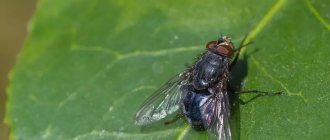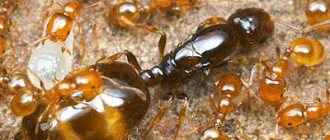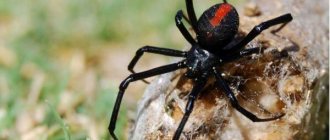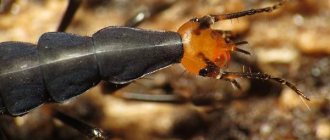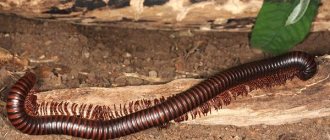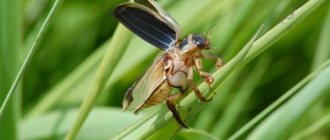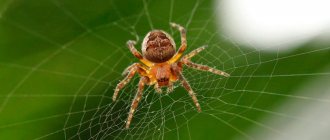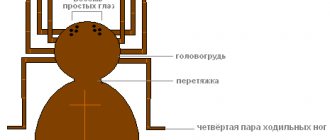Having a huge spider as a pet is certainly very impressive. Spiders are interesting to watch, and at the same time they do not make noise, do not litter, and do not chew shoes. Spiders do not need communication or tactile touch at all - the less you disturb them, the better they will feel. These are ideal pets for those who want to feel close to wildlife, but at the same time suffer from a catastrophic lack of free time. And, of course, spiders have a unique, vibrant and terrifying beauty.
It's no secret that despite all their advantages, spiders cause horror and disgust in most people. But most spiders are not dangerous and are even useful, because they destroy annoying small insects. By regulating the number of flies and midges, spiders help our ecosystem.
However, among them there are also very dangerous predators, whose bite can be fatal. In our selection you will see the most beautiful spiders in the world - among them there are both very poisonous and completely harmless.
Peacock spider
An incredibly beautiful creature. The abdomen of this colorful spider resembles a peacock's tail. Seeing a female, peacock spiders lift up and expand their abdomen, trying to attract her attention. As soon as the “girl of his dreams” approaches the male, he begins fiery dances, lifting his paws up and dynamically moving from side to side.
You can see this handsome man in the eastern part of Australia.
Metallic arboreal tarantula
The huge electric blue tarantula is rightfully considered one of the most beautiful spiders on the planet. It is often kept in home terrariums; many exotic lovers dream of getting such a miracle.
However, we would not recommend that you buy such a non-standard pet. The metal tree tarantula is very poisonous, and its bite can cause not only unbearable pain, but also lead to such unpleasant consequences as arrhythmia, tachycardia, disorientation, convulsions and tumors. No fatalities from the bite have ever been recorded.
Spider crab
This creature tries very hard to hide its kinship with its own kind. To do this, the crab spider has learned to move not only forward and backward, like all its relatives, but also to the side. Zoologists cannot yet explain why he needed such a bizarre method of movement.
This is not the only amazing property that the crab spider is capable of. It also has the ability to change its color to blend into the background or the prevailing color in its surroundings. The mechanism is based on the same principle as that of chameleons. Thanks to this adaptability, hunting becomes easier: they do not need to quickly overtake their prey, and be left without dinner if it has managed to escape. Instead, you can sit on a yellow, white or pink flower and blend in with it in one shade, lying in wait for potential food.
Because of this original method of hunting, the crab spider does not need to weave a net into which insects will fall, and most of its hunting skills have long been lost, but the amazing features of this creature do not allow it to remain hungry.
Martinique mahogany
Newborn Martinique mahogany spiders are dark blue with white stripes. However, as it matures, many red areas appear on it. Mature individuals have metallic green hairs - it seems that these beautiful spiders just love experimenting with coloring.
The sting of a Martinique mahogany tree feels the same as a wasp sting. They attack only in a desperate situation, when they feel a threat to their own life.
Pamphobetus platioma
A huge spider whose paw span can reach twenty centimeters. This absolutely beautiful spider was included in our selection thanks to its soft, plush purple fur. However, only males have such an unusual color; females are content with a rather mediocre brown color.
These spiders are not suitable for keeping at home, because they absolutely cannot tolerate human touch - they immediately want to attack the one who dares to invade their personal space. If you try to pull the spider out of its hiding place, you cannot avoid a bite.
Smiling spider
Yes, yes, the inventor of the smiley was nature itself. A smiling face seems to be painted on the abdomen of this cute spider. The smiling spider really looks very cute and positive.
This cute little guy is a native of Hawaii. It has a very modest size (body length - no more than 5 mm) and is not capable of causing any harm to humans.
Peacock spider (Maratus volans)
The title of the most beautiful spider in the world also belongs to the jumping horse, it is called the Peacock Spider (Maratus volans)
The peacock is a small, brightly colored spider. The length of its body does not exceed 5 mm. Males are very bright, females are pale, unpresentable and very aggressive towards the opposite sex.
During the mating season, the spider selects a bride and begins to dance in front of her, raising its abdomen and spreading its third pair of legs. He tries, moves energetically and hopes for reciprocity. If he can arouse the interest of a representative of the fairer sex, he may survive. Otherwise, the female will catch and eat the annoying suitor.
Spiny Spider
This cute spider has many names - spiny spider, horned spider, spiny orb spider. Along the edge of its wide abdomen there are six sharp horns, which should give the spider a threatening appearance and scare away natural enemies from it. The body length of this tiny spider does not exceed three millimeters - so it is unlikely that anyone is really afraid of it.
You can see this little miracle in the tropical and subtropical forests of the USA, Central America, South America, the Bahamas, Australia and the Philippines. Spiny spiders prefer to weave webs near swamps and streams.
What do spiders eat?
Spiders are quite original creatures that eat very interestingly. Some types of spiders may not eat for a long time - from a week to a month or even a year, but if they start, there will be little left. Interestingly, the weight of food that all spiders can eat during the year is several times greater than the weight of the entire population living on the planet today. How and what do spiders eat? Depending on the species and size, spiders forage and eat differently. Some spiders weave webs, thereby organizing clever traps that are very difficult for insects to notice. Digestive juice is injected into the caught prey, corroding it from the inside. After some time, the “hunter” draws the resulting “cocktail” into his stomach. Other spiders “spit” sticky saliva while hunting, thereby attracting prey to themselves.
The main diet of spiders is insects. Small spiders happily eat flies, mosquitoes, crickets, butterflies, mealworms, cockroaches, and grasshoppers. Spiders that live on the surface of the soil or in burrows eat beetles and orthoptera, and some species are able to drag a snail or earthworm into their home and quietly eat them there.
The queen spider hunts only at night, creating a sticky web bait for unwary moths
Noticing an insect next to the bait, the queen spinner quickly swings the thread with her paws, thereby attracting the attention of the prey. The moth happily hovers around such a bait, and having touched it, it immediately remains hanging on it.
As a result, the spider can calmly attract it to itself and enjoy its prey.
Large tropical tarantula spiders happily hunt small frogs, lizards, other spiders, mice, including bats, as well as small birds.
And this type of spider, such as the Brazilian tarantula, can easily hunt small snakes and grass snakes.
Aquatic species of spiders get their food from the water, using their webs to catch tadpoles, small fish or midges floating on the surface of the water. Some spiders, which are predators, due to the lack of victims, can also get enough of plant food, which includes pollen or plant leaves.
Haymaking spiders prefer cereal grains.
Judging by numerous notes by scientists, a huge number of spiders destroy small rodents and insects several times more than the animals living on the planet.
Karakurt
One of the most dangerous spiders, which is also called the “steppe widow”. On the upper side of the black belly of the karakurt there are thirteen red spots - and this fatal number perfectly conveys the demonic character of this creature.
Karakurt does not attack on its own - only if it is disturbed. Those who have been bitten by the steppe widow have a hard time - unbearable burning pain spreads throughout the body, shortness of breath, tachycardia, disorientation, headache, nausea, increased sweating, hallucinations and delirium begin. Without immediate medical intervention, death is possible.
Be careful while on vacation in Crimea and the Azov region - steppe widows are found there quite often.
Deadly poisonous spiders
As a rule, the majority of spider species are not dangerous to humans. The only problem is the presence of cobwebs in the most inappropriate places for humans. It should be noted that there are very poisonous species, the bites of which can be fatal to humans.
Deadly ones include:
- Black widow, as well as karakurt.
- Brazilian spiders.
- Brown recluse spider.
Best articles: Ebolavirus: infection process, viral structure and immune response
Black widows received such an interesting name due to the fact that after mating, if the male does not have time to leave, the female simply eats him. This dangerous species is distributed across almost all continents. They hunt their prey like a lasso using their web. The most famous in this regard is the American black widow, and as for the other representatives of this genus, they do not pose a serious danger.
North American black widow
On the North American continent, you can find up to 5 species of black widows, which are distinguished by their black body color with the presence of red spots on the abdomen.
The main distinguishing feature of this kind of spider is the presence of long legs, as evidenced by photographs of these dangerous animals. A spider bite is somewhat similar to a pin prick, but after 30 minutes muscle cramps appear that spread throughout the body. When serums had not yet been invented, up to 5% of victims died from their bites.
South American black widows
Representatives of this genus, living in South and Central America, have been studied very little. It is known that up to 8 species live in these places. This is due to the fact that spiders inhabit hard-to-reach places that are not so easy to reach.
Karakurt
These poisonous and dangerous arthropods live in Eurasia and Africa. There are up to 18 varieties of them, differing in varying degrees of danger. These are the same black widows, but they are called karakurt here. Black karakurt prefers to live in the southern regions of the continent, including Crimea and the Mediterranean. Due to the fact that global warming processes are observed on the planet, black karakurt was found in colder regions. As a rule, the ideal conditions for this arthropod to live are high temperatures above zero.
The image and name of the spiders do not correspond to reality, since these types of karakurts are distinguished by the presence of large red spots on the back. The coloring of spiders can vary due to the fact that Eurasian species often interbreed. As a result, black karakurt can have a pure black color.
Latrodectus geometricus
The black widow of this species is distributed on almost all continents. If you look from the back, the spider is brown in color, and the red spot is located on the lower part of the abdomen. This black widow's paws are yellow-brown, and black stripes can be seen on their bends. Of all the representatives of this genus, it is considered the least dangerous creature and poses a danger only to children and the elderly.
Brazilian wandering spider
Until recently, it was believed that black widows were the most dangerous species of spider, but by 2010, the most dangerous species became known - the Brazilian soldier spider. The genus of these most dangerous arthropods includes about 8 species. Their habitat is limited to the tropics of South and Central America. The most interesting thing is that spiders of this species build hunting webs and hunt in an active way.
After being bitten by a soldier spider, paralysis and suffocation occur. As a result of poison entering the blood, in 85 cases out of 100, complete cardiac arrest occurs.
Recluse spider
This is one of the species that represents the North American continent. Body color can be either brown or dark yellow or gray. The size of the paws can range from 6 to 20 mm. The recluse spider has only 6 eyes, compared to the majority of species. This can be seen in the photo if you enlarge the image.
During the daytime it prefers to be in shelter, and goes out hunting in the dark. Despite the fact that he does not hunt with the help of a web, he still weaves a web, but uses it as a shelter. It can easily be found in a person’s home, so it can easily climb into bed. If you press him down, he will certainly bite.
Over time, a necrotic ulcer forms at the site of the bite, which can heal for several years. There are also fatal cases when a child or a person with weak immunity becomes a victim of a bite.
10 Most Dangerous Spiders in the World
Watch this video on YouTube
Brazilian white-knee tarantula
A very large spider with quite interesting coloring. The body length of an adult individual reaches nine centimeters, and the paw span can be up to twenty centimeters. Brazilian white-knee tarantulas can be quite aggressive, but due to their natural slowness and clumsiness, they are not considered dangerous.
Of course, this giant is poisonous, but its poison cannot pose any danger to humans. The most unpleasant thing that can happen to you after contact with a Brazilian white-knee tarantula is irritation and itching.
These spiders are often purchased by lovers of exotic pets, and can live in captivity for up to fifteen years - the care of their owners benefits them.
Cross spider
There is a claim that the cross spider is dangerous to humans, but in fact this is a myth - one of the most common spiders is poisonous only to small animals: rats, mice, etc.
The cross spider is considered peaceful, but can cause some inconvenience when relaxing outdoors. This species prefers places with high humidity and can most often be found in gardens or shrubs growing near water bodies.
The spider got its name due to its appearance - on the back of the arachnid there is a cross formed from white spots. Female crosses are larger than males - their sizes reach 25 mm, and the male does not exceed 11 mm.
Argiope Brünnich
People call these beautiful creatures “wasp spiders.” These are medium-sized spiders - the body length can slightly exceed three centimeters in females. Males of Argiope Brünnich are very small - about five millimeters.
Females of this species are easy to recognize due to their outstanding external characteristics - a striped yellow-black abdomen and very long legs. But the males are completely unremarkable - black or gray.
Photos and names of house spiders
To understand the degree of danger of a spider, you need to know its species. The characteristics and characteristics of all arthropods that often inhabit human homes should be considered.
Haymaker
The haymaker spider often lives in window frames and corners of apartments and houses. They can often be found in attics. These creatures have an oval body, reaching about 1 cm in length. This species is distinguished by long legs that are beige or brown in color. The body is gray-brown. Haymakers weave a chaotic web.
Their numbers in residential buildings increase in the fall. Haymakers are extremely shy, so if they are disturbed, they try to quickly hide. If life is threatened, the spider may bite. These creatures are non-poisonous and therefore do not pose a danger to humans.
Black house spider
Black spiders are often found in corners, on the ceiling and walls of apartments. The female of this species can reach 3 cm, while the males are 2 times smaller. They weave a tube-like web. The diet of black spiders includes not only flies, but also moths, butterflies, beetles and other insects that accidentally enter the living room. Living in a house, they rarely reproduce.
Hobo spider
Vagrants are small in size. They rarely grow to 1 cm in length. This species of arthropod has 8 pairs of legs. The hobo's shell is brown with black and beige patches. This house spider differs from its relatives in that it does not weave a web. This creature is constantly moving. During a hunt, it quickly attacks the prey, injects its poison and eats it. The venom released by this type of spider is safe for humans.
Jumper
It is relatively rare for jumpers to be found in apartments. In most cases, they are carried indoors on a person’s clothing. Jumpers have a special structure of their legs, thanks to which they move by jumping. In addition, this type of spider is able to quickly move across glass. The jumper, unlike other varieties, has good eyesight. It has 8 eyes arranged in 3 rows. These creatures are safe. They do not emit poison, because... consume only plant foods. The basis of their diet is acacia.
White house spider
A simple white spider is also common in the house. The body length of females of this species reaches 1.5 cm, and males are much smaller. These arthropods weave large webs. Their poison is not dangerous to humans. At the same time, white karakurts are found in the southern regions of Russia. They have thin legs and a thick spherical body. White karakurts are rarely found in a house or apartment, but it is impossible to exclude their entry into living quarters. The venom of these arthropods can cause allergic reactions and signs of intoxication.
Best articles: List of the best and most beautiful national parks on Earth
Maratus personatus
This is probably the cutest spider on the planet. We're willing to bet that these amazing creatures can make even the most ardent arachnophobe smile.
These furry babies do not grow more than five millimeters. But small sizes and non-standard colors are not all of their advantages.
The most beautiful thing about these spiders is the way the males court the females. They perform amazing dances, lifting their paws up - believe me, it looks very funny.
Eresus
These are very small spiders - their body length is rarely more than one centimeter. Eresus males have a red-orange abdomen with black spots, and females, alas, do not have an unusual color. Males often have white rings on their legs.
Eresus dig deep holes underground, in which they set up their own home. They hunt flies, butterflies, and beetles.
The bite of these spiders is very toxic and can even be fatal. Unfortunately, these beautiful but dangerous spiders are quite common in our country.
2500+ most interesting nicknames for spiders
What nickname should I give the spider? This question is faced by many lovers of these beautiful creatures, and it is for these people that this article was created, which collected the coolest, original, unusual, popular, beautiful, funny and cool nicknames for spiders. Thanks to this list, you can easily choose a worthy name for your pet.
When choosing a name for a spider, Russian, English, French, German and Japanese names are most often used. Foreign names are always on trend and sound very fresh to those who are used to Russian names, so it would be best to choose a name from a language you don't speak.
Choose a name for your pet wisely, because you can’t just change the name later. I hope this list was able to help you.
The coolest and best (TOP 50)
Ornette Dream Onafiel (moon angel) Yurzik Alta (tall) Zadtra Jean Baptiste Pencil Vincent Durex Bonnie Sheetsy Genghis Cat Nora Frost Morio (forest) Bender Mayumi (gentle beauty) Sugan Ero (happy, joyful) Winnipooh Bruce Carbon Kato Olvi Elurus Streak Genghis Cat Fumio (smart, smart child) Kölsch Omelette Find Jet Carno Gimli Sadie Tammy Toktar Roll Penny Lala Glory Barbie William Shakespeare Bali Zhivago Tansay (devoted) Shagana Ciel (heaven) Harlequin Wayland
Simple and easy
Peso Harvey Troy Hasya Gendarme Phiset (unique, special) Elva Latoya Urs Collin Yasnaya Humbert Seed Nabat Kherson Gunn Tori Machiavelli Santina Kokoro (soul) Rustic Margot, Margaret (pearl) Stanford Balto Yungun Mystery Lapusya Osta Roxy Havroshechka Selma Wei (possessing irrepressible energy) Jali Point Ardent Nimrod Ricochet Ostap Obelisk Jazz Popandopalas Rombik Lauren
Beautiful
Paddock Greya Luna Mazda Miraz Adelaide (noble origin) Young Jerome Julia Pard Lukomorye Cat Talmir Adelaide, Adeline, Adelais (noble) Damphis Kaleria Begonia Gabrielle Citron Katran Laarchin Adonis Esker (result of something) Feller Bohemia Cream Safokles Adelia Grona Adamant Yusik Muroslav Paula Young Christophe Elvis Catsley Anet/Annette/Aneis (grace, benefit) Truman Felicia (luck) Fedya Adella Assel Yuji Balt Timber Pard Lothar
Cool and funny
Yunkolas Joquil Zorya Chaif Peanut Chucha Pi-Katso Yanitochka Earl Pompon Razdan Kenai Etching Sirin Baskov Sniper Darg Borka Julia Honduras Lika Theodore Vaflik Dobrynya Bayun Ever Ilyas Twilla (twilight) Goulash Catsy Kline Constance Nakhti (strong, powerful) Yanula Eeyore (eared companion Winnie the Pooh) Egon Zander Falstaff Nicoletta iPhone Accident Sarmatian Bandit Chuchundra
Popular
Simha (Hebrew “happiness”) Samba Fairuch Ursus Yuzver Aniko Bunny Patron Berserk Hermes Danger Purr-fect Dernis Sitka Nor Shonna Trapezium Aramis Danelia Tabata On Choi (graceful, graceful) Teddy Nicey Schnell (fast) Tennyson Tyutya Sonya Blaine Lesta Kofa Ulka Disney Joseph Lightning
Unusual, interesting and original
Abus Basta Cole Yanushka Brita (sublime) Amayo (rainy night) Karakurt (black wolf) Demi Meow Ewok Ratibor Dark Angel Pasta Hedgehog Psycho Ingbluz Alphonse Ardek Wager Darkness Noah Adamal Baikal Romilda Vincetti Amanita Crypto Meow Waldy Wolf Baroness Mrs. Nori Yomma Shrek Riggs Gillis Assor you Barça
For furry
Freckle Danya Darika Freckle Gatsby Danya West Wind (wind) West Hobbes Adanami (sound of waves) Wind (wind) Dara, Tao (star) West
For black
Darge Vivaldi Daniel Dar Darth Vader Daria Gapit Dar View Werner (“guardian”) Darkley (darkness) Danko Danko Gehenna (Hell in the New Testament) Darty (dark as darkness itself) Griffin Darya Gagata (a coal-black stone that was used in amulets, amulets and in witchcraft) Batman Granita Griffin Batman Vivaldi Bogira Asia (gloomy) Grif Dallas Adgam (black) Black Grigori (fallen angel) Griffin Bagira Viol
For white
Velor Belchik Black Velvet White Gavin (hawk) Albern (white) White White Belyanka Snow White Black Magic Veles Gavin (hawk) Vatan Vatan Gavin (hawk) Albino Belyanka Albern (white) Albino Belomor Vector Weiss Black Magic Belchik Wiggle Blondie Belomor Veronica Albino Arctic Alva (light) Velor
For the redhead
Adamina (red-haired) Akadama (amber-colored) Darina Vera Rubin Darina Scarlet Gregg (vigilant and careful) Versailles Verne Danuta Gazelle
For gray
Argentum Azelstan (noble stone, so you can call a gray cat) Argyris (silver) Argenta (silver) Weyhouse Dhaka Aurum Vizier Aurum Vizier Grimalkin Gray Aurum Grayson Grice Aurum Gray Grimalkin Groucho Argyris (silver)
Russians
Gunya Azart Vitya Ross Gryzya Knight Chumazin Armor Pinocchio Bonka Ustya Vasil Barin Granite Vitamin Veniamin Borzik Guslyar Bayan Sparrow Granite Granite Garik Garik Bronze Curly Squirrel Marcelos Chumazin Volga Minion Leader Gzhel Gosha Bronze Bronze Terrible Bosya Vsevolod Alevtina Marcelos Antoshka Grozny Haveriy Golubok Aksinya Little Dove
English
Noort Reko (freshness) Nargiz Remington Ash Snowball Brody Golden Honcho (leader, first) Morozhka Fris Zhostik Xanxus Picacchu Maron (chestnut) March Clepsydra Culumbus Monty Smoke Dymych Sugar Lulu Gerard Zainab Egor Sloan (little raider) Euphrates Idizhrat Catstello Willow Date Eileen Lure Wizard Montana Christina
German
Daisuke (best assistant) Raphaela Creed Pastel Wilfred Prize Fenriz Froska Dumka Lu Nova Ferry Walden (German) Wendel ("wandering") Jordan Hilda Darena Krepysh Ziko Lotta
French
Gregoire (vigilant defender) Adier Gobi Beaumond Vivien Antoinette Guyem Vitoire (winner, victory) Bonaparte Garcon Garcon Antoinette Antoinette Victoria Engraving Bless Guyem Garnerry Glatton Gaspard Bordeaux Gautier Victoria Guyem Antoine Garcon Gascon Allen Gregoire (vigilant defender)
Japanese
Azzo Buke (hereditary samurai) Azzo Atsuko (warm, cozy) Aikido (road to harmony, mental balance) Ayumu (flying in a dream) Aikido (road to harmony, mental balance) Akito (autumn) Aori (wind) Bansei (eternal)
Rare
Carlson Currant Davis Armin Realia Stasik Sunny Afiya Purrfect Bungee Winda Augustine (venerable) Star Liebchen Blanchefleur (white flower) Polina Terry-Mack Eku (winged) Basiliano Murdock Reflect Kenna Bonduka (victory, winner) Urartu Joke Setty Eustace Bengal Lot Sem Doe Nyumchik Ivashka Glada Sever Nils Chernilkin Barrat Gargarush Totosha Vikhter Renata Chaya
Article rating:
If you liked the article, share it with your friends!
Maevia inclemens
These are small spiders that live in Canada and the USA. They made it into our selection due to their huge eyes, which make them look like cartoon characters.
The body length of females is up to eight millimeters, males – up to seven millimeters. The abdomen is beige, with sparse orange hairs and black stripes. There are males with a black body.
Goliath tarantula
One of the largest spiders on the planet. Twenty years ago, a goliath tarantula was caught in Venezuela with a paw span of twenty-eight centimeters.
These huge spiders can be seen in the rainforests of Brazil and Venezuela. Goliath tarantulas live in deep burrows and only go out hunting at night. These spiders have an aggressive, nervous nature, and do not like human touch too much.
North American black widow
A poisonous spider that can be seen in North America, Australia and Oceania. The color is, as the name suggests, black. You can often see an hourglass-shaped mark on the abdomen. Females that have not reached adulthood have a white outline around the red spots.
After copulation, the females of this species eat the males. The bites of this spider are extremely toxic and can be fatal even after taking an antidote.
Eight-spotted crab spider
It is not clear why this spider was called 8-spotted (Octomaculatus from Latin octo - “eight” and maculatus - “spotted”)
The eight-spotted crab spider was described by Carl Ludwig Koch in 1845, but this rare species has still not been sufficiently studied. Found on the islands of Indonesia. In appearance, it is a slightly flattened yellow or orange spider with noticeable black markings on the cephalothorax and abdomen. The largest known was 0.4 cm long. Bright coloring is needed for camouflage. He spends most of his time on flowers, waiting for unsuspecting bees to fly in to collect nectar and fall right into his paws.
Mirror Spider
An amazingly beautiful work of nature. This little spider looks like an iridescent gem. Its abdomen is covered with small mirror plates. Mirror spiders are very small, they do not grow more than four millimeters. Surprisingly, the size of the mirror plates depends on the emotional state of the spider.
This miracle lives in the eucalyptus forests of Australia and Singapore.
Jumping spiders
The huge family of jumping spiders includes more than 610 genera and 5,800 species, which are found everywhere except in cold latitudes
Jumping spiders got their name from their ability to jump far and high. Recently, the mechanism of their jumping has been studied more thoroughly. It turned out that the problem was a well-developed internal hydraulic system. Spiders can expand their limbs by changing the blood pressure in them, and this allows them to make a very strong push. Jumping spiders usually hunt during the day. They do not weave hunting webs, they sneak up, suddenly jump on prey and bite it, paralyzing it with poison.
Interestingly, before jumping, spiders insure themselves with a silk thread, attaching it to the place from which they are going to jump. It can be high to fall.
Jumping spiders have good vision, they can see up to 40 cm away, and the viewing angle of 8 eyes is almost 360 degrees. Unlike other spiders, they climb glass easily thanks to their small hairs and claws. In case of danger, they will prefer to hide; if this does not work out, they take a typical defensive pose: they raise their front paws and begin to quickly wave them, trying to scare the aggressor.

